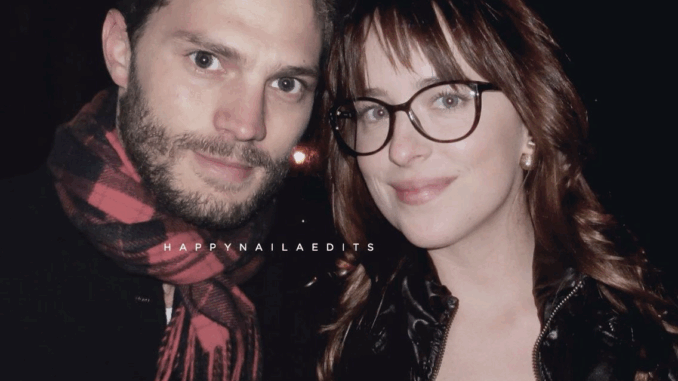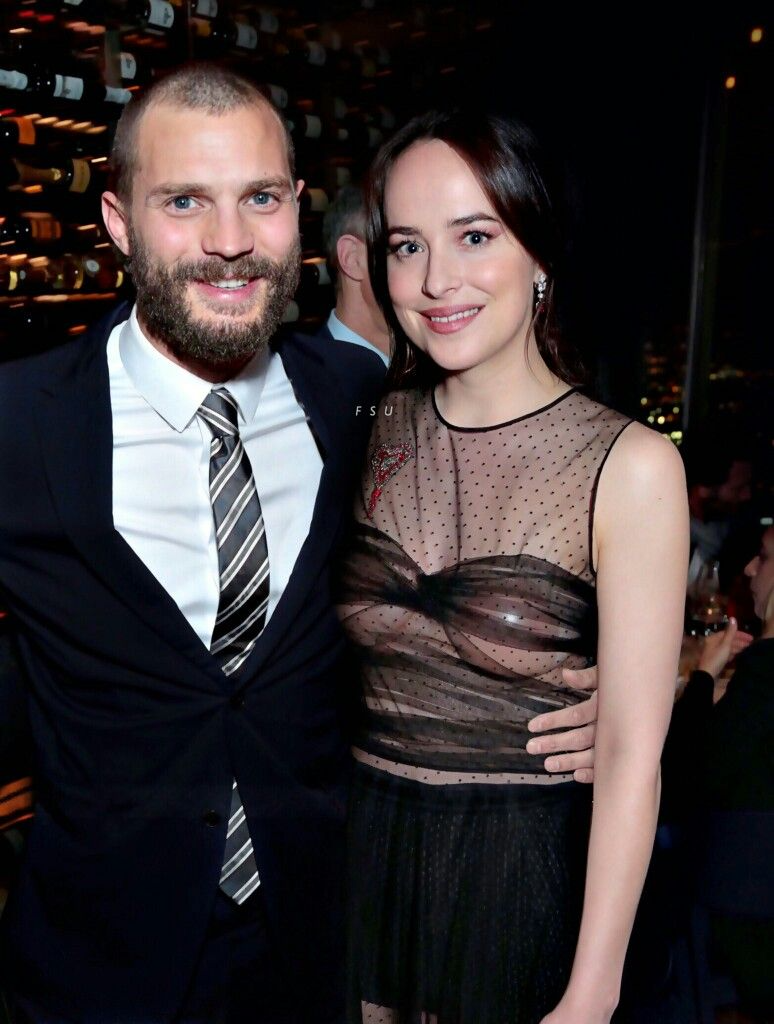
Jamie Dornan and Dakota Johnson became global icons when they stepped into the roles of Christian Grey and Anastasia Steele, but as much as audiences obsessed over the fiery on-screen connection between them, whispers behind the scenes painted a far more complicated, even contradictory, picture. Fans adored their chemistry, yet rumors kept swirling that the actors could hardly stand each other when the cameras stopped rolling. This paradox—apparent heat on screen, alleged frost off screen—has fueled years of speculation, and the fascination has only deepened as both stars have gone on to carve very different paths in Hollywood. So what really happened? Did they secretly hate each other, or was the truth much messier than the gossip?
From the very start, Fifty Shades of Grey was a phenomenon destined to divide audiences. Based on a book series that dominated bestseller lists and stirred equal parts excitement and ridicule, the film carried a heavy weight of expectation. Casting was always going to be crucial, and when Dakota Johnson, daughter of Hollywood royalty, and Jamie Dornan, a model turned actor with smoldering intensity, were announced, the public had mixed reactions. Fans questioned if they had the right look, the right chemistry, or even the right courage to carry such daring roles. The pressure was immense, and both actors admitted in later interviews that they felt the scrutiny before cameras even rolled. In this high-stress environment, it’s no surprise that whispers of tension started to creep into the narrative.
Press tours became a breeding ground for speculation. Observers pointed out Jamie’s stiff body language in certain interviews, or Dakota’s tendency to joke defensively when asked about intimate scenes. Clips circulated online showing awkward silences or forced smiles. Social media amplified every micro-expression, every subtle gesture, turning them into alleged evidence of dislike. “They don’t even look at each other,” fans tweeted after one red-carpet moment. “They’re just faking it for the cameras,” another wrote, igniting debates in forums and gossip sites. While such observations were subjective, the sheer volume of them created a storyline of its own: that the stars were locked in a private battle of endurance rather than basking in genuine camaraderie.
Crew members occasionally fanned the flames, though always anonymously. Some claimed that entire love scenes had to be re-shot due to lack of connection, while others suggested that tension made those very scenes more compelling. One supposed insider hinted that Dakota, known for her dry wit and independent spirit, clashed with Jamie’s more reserved approach. Another insisted that both actors were professionals, committed to the job, but simply lacked off-screen friendship. Whatever the case, the rumors refused to die, and the trilogy carried an extra layer of intrigue because of it. Fans weren’t just watching Christian and Ana—they were hunting for hidden signs of real-life animosity.
Psychologists often say that chemistry isn’t always about love. Sometimes it’s about tension, friction, or even subtle conflict. When two people rub against each other emotionally—whether in harmony or discord—it creates energy. On screen, that energy translates as sparks. Could that explain why Jamie and Dakota’s connection felt so raw, so electric, even when critics slammed the script or direction? Was their alleged off-screen frostiness the very ingredient that kept audiences hooked? It’s a tantalizing theory, and one that many industry insiders quietly agree with.
Dakota herself seemed aware of the narrative. In interviews years later, she laughed off the rumors, calling Jamie one of her closest collaborators, emphasizing the trust they shared during challenging shoots. “We had to rely on each other completely,” she said, pointing out that filming explicit scenes demanded vulnerability and mutual respect. Jamie, too, dismissed the idea of bad blood, though his explanations were often shorter, more guarded. To skeptics, those reassurances sounded rehearsed; to others, they were proof that fans had read too much into awkward press junkets. Yet the fascination lingered, because contradictions persisted. One moment, Dakota praised Jamie’s dedication. Another moment, she hinted at creative disagreements or admitted the experience was “weird.” Fans cherry-picked quotes to build their preferred version of reality.
There’s also the factor of fame itself. Both actors entered Fifty Shades at transitional points in their careers. Dakota was trying to step out of her parents’ shadow, desperate to prove she was more than just Hollywood lineage. Jamie, meanwhile, was navigating the leap from modeling and smaller roles to full-blown stardom. The spotlight was blinding, and neither could fully escape the judgment, mockery, or fetishization that followed the franchise. Imagine being thrust together in such circumstances, expected to perform the most intimate acts under hot lights, then answer endless invasive questions about it for years. Even the most compatible colleagues would feel strain. It wasn’t necessarily dislike—it might simply have been exhaustion.
And yet, fans crave a clear answer. Did they hate each other or not? The truth likely lies in the middle. They may not have been best friends, but they were allies bound by an unusual project. They may not have shared private dinners or lifelong bonds, but they built enough trust to complete one of the most high-pressure trilogies in modern film. In many ways, that’s even more impressive than a rosy friendship narrative. It shows discipline, resilience, and the ability to put craft above comfort. Still, gossip has a way of overshadowing nuance, and the myth of a feud remains far juicier than the reality of professionalism.
Another layer worth exploring is how the alleged tension became part of the trilogy’s legacy. Fifty Shades was never just about love; it was about power dynamics, control, vulnerability, and resistance. Christian and Ana’s relationship thrived on imbalance and negotiation. Perhaps subconsciously, audiences projected the rumored off-screen imbalance onto the characters, deepening the illusion of authenticity. In this sense, whether Jamie and Dakota liked each other mattered less than the fact that audiences believed they didn’t—and that belief added fuel to the phenomenon.
Over the years, both stars have spoken with increasing candor about the challenges of the franchise. Dakota admitted that the set was often chaotic, with script rewrites and creative disputes. Jamie confessed to discomfort in certain moments, balancing the need to honor the source material while maintaining personal boundaries. These confessions humanized them, reminding fans that beneath the glossy veneer of fame were two young actors navigating an unprecedented storm. Still, neither has ever explicitly confirmed a feud. Instead, they’ve carefully walked the line between honesty and discretion, allowing the public to imagine whatever version of their relationship best fits the fantasy.

What makes this story endure is its ambiguity. If Jamie and Dakota had outright declared eternal friendship, the intrigue would have died. If they had admitted to animosity, the mystery would have dissolved into tabloid fodder. By leaving space for interpretation, they created a living myth, one that continues to fascinate nearly a decade later. Fans debate in online forums, rewatch press clips for hidden clues, and argue passionately about whether the chemistry was love, hate, or both. It’s become a kind of participatory game, where speculation is the entertainment.
And maybe that’s the real untold truth: that the ambiguity itself was intentional. Hollywood understands the power of mystery. A perfectly polished friendship is forgettable. A rumored feud, however, is magnetic. By never fully resolving the tension, Jamie and Dakota allowed the audience to remain invested long after the credits rolled. Every awkward glance became a clue, every hesitant smile a puzzle piece. Whether by design or coincidence, the lack of clarity ensured that the Fifty Shades phenomenon extended beyond the screen, into endless conversation.
In the end, it may not matter whether Jamie and Dakota liked or disliked each other. What matters is the story their relationship allowed the world to tell: that sometimes, the line between truth and performance is so blurred it becomes indistinguishable. Their alleged feud, their supposed coldness, their undeniable on-screen chemistry—all of it combined to create a cultural moment that still sparks debate. And as long as people keep asking “did they really hate each other?”, the myth of Fifty Shades will never fade.
So, did they? Maybe yes, maybe no. Maybe the real answer is that their relationship was as complex, layered, and contradictory as the one between Christian and Ana. And perhaps that’s why the trilogy continues to captivate—because behind the scenes, just like on screen, love and hate are often two sides of the same coin.
